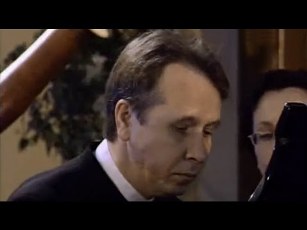Beethoven & Rimsky-Korsakov – Piano Quintets (2002)
Beethoven & Rimsky-Korsakov – Piano Quintets (2002)

Beethoven – Piano Quintet Es-Dur, op.16 (1796) 1. I. Grave - Allegro ma non troppo 2. II. Andante cantabile 3. III. Rondo: Allegro ma non troppo Rimsky-Korsakov - Piano Quintet B-Dur, op.posth (1876) 4. I. Allegro con brio 5. II. Andante 6. III. Rondo: Allegretto Mikhail Pletnev & London Winds: Mikhail Pletnev – piano Gareth Hulse – oboe (1 – 3) Philippa Davies – flute (4 – 6) Michael Collins – clarinet Robin O'Neill – bassoon Richard Watkins – horn “Cherrish Woods” Festival Moscow, 19.05.2002
Written in the mid-1790s, when Beethoven still toiled in the shadow of Mozart and Haydn, the Quintet for Piano and Winds shows the strong influence of the two elder composers, as do the six string quartets of Op. 18 he was composing at about the same time. Yet Beethoven was already beginning to assert his own personality here through the occasional violent contrast in dynamics. The writing for winds strongly recalls Mozart's woodwind serenades, but the sometimes rumbling and ever forceful piano style anticipates Beethoven's later keyboard works. And unlike Mozart, Beethoven sets the piano in opposition to the block of woodwinds. He also made an alternate quartet version with the same opus number, replacing the winds with violin, viola, and cello.
The first movement begins with a placid introduction, marked Grave; it's like a distant hunting call for winds answered lyrically by the piano, then approaching nearer (and louder). The piano takes charge as the movement's main matter, Allegro ma non troppo, gets underway. It starts with a charming, antique tune immediately repeated by the winds and then used as the basis for rapid, keyboard-roaming passagework on the piano. There's a rustic dance-like melody, and eventually the keyboard introduces a third, more placid but rhythmically decisive theme, soon shouted out by the winds. Beethoven puts these themes through the standard sonata-form development, but when it's time for the recapitulation, the jokester Beethoven brings back the themes in the "wrong" key, according to the classical formula.
The second movement, Andante cantabile, balances lyricism with counterpoint. It's a rondo, with the serene main theme increasingly ornate in its second and third appearances. The first contrasting episode is a dialogue between oboe and bassoon, answered by canonic figures in the other winds. The second contrasting episode features a minor-key horn solo. The final return of the main theme, however florid it becomes, ends with quiet scale passages in contrary motion.
The finale, Allegro ma non troppo, is also a rondo, but one that develops the primary thematic material -- another hunting tune, gently called out first by the piano -- almost as fully as in a sonata-allegro format. The first contrasting episode is all arpeggios, first in the piano and then in the winds, elements that will return through the rest of the movement. Indeed, the work ends in a string of joyful, rustic arpeggios and hunting calls. --- James Reel, Rovi
Nikolai Rimsky-Korsakov's Quintet for piano, flute, clarinet, horn and bassoon was written in 1876 for a chamber music competition. It was not a successful entry, losing out to a composition by Czech composer Eduard Napravník. The Quintet has three movements; the first, Allegro con brio, is "in the classical style of Beethoven" according to the composer. Conversely, its style is very different from every other work of Rimsky-Korsakov. The second, Andante, in contrast, is the direct product of Rimky-Kortsakov's "Russianness." It opens with a horn melody accompanied with piano chords. Together, the winds create an atmosphere tinged with melancholy, while the piano accompanies for most of the time. The third, Rondo, Allegretto vivace, begins as a dance tune that gradually becomes more serious until the rhythm stops altogether. After an complicated section for solo piano, the dance rhythm of the beginning is reintroduced for the closing pages. ---Rovi
download (mp3 @320 kbs):
yandex 4shared mega mediafire zalivalka cloudmailru uplea ge.tt








